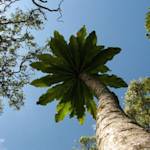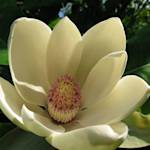African baobab tree
2023 CE • Africa
"The magnificent baobab tree (Adansonia digitata) is an icon of the African continent. With bark and fruit offering over 300 life-sustaining uses, it is the root of many Indigenous remedies, traditions, and folklore. Hence its literal nickname, ‘The Tree of Life.’ Predating humankind, this prehistoric species is over 200 million years ago . . . Known to reach up to 100 feet tall with a circumference to match, these trees are enormous, providing shelter, food, and water for various life forms. Indigenous African savanna peoples have long centered their communities around these monumental trees. Baobab trees are fundamental to the entire dry African savanna ecosystem. They help keep soil conditions humid, aid nutrient recycling, and slow soil erosion with their massive root systems. In an arid climate, baobabs symbolize life in a landscape where little else can thrive . . . They are also an essential source of water and shelter for hundreds of animals, including birds, lizards, monkeys, and even elephants – which can eat their bark for moisture when there is no water nearby. Bats pollinate the flowers, feeding on their nectar . . . For humans, the baobab’s fruit pulp can be eaten, soaked in water to make a refreshing drink, preserved into a jam, or roasted and ground to make a coffee-like substance. The bark can be pounded to make everything from rope, mats, and baskets to paper and cloth. Leaves are also used, they can be boiled and eaten, or glue can be made from their flower’s pollen. Throughout the Zambezi, Indigenous communities note the baobab for its branches that seem to span out in all directions like roots . . . Indigenous peoples have learned, through centuries, to live harmoniously with these majestic trees, thriving off of their many uses without depleting them. However, due to climate change, nine of thirteen of Africa’s oldest and largest baobab trees have died in the past decade. Scientists speculate that warming temperatures have killed the trees directly or made them weaker and more susceptible to drought, diseases, fire, or wind."
Lindsey Jean Schueman, "African baobab tree: how one plant creates an entire habitat," One Earth, September 21, 2023.
Image: Bernard Gagnon, CC BY-SA 3.0, via Wikimedia Commons


Learn about Maya Lin’s fifth and final memorial: a multi-platform science based artwork that presents an ecological history of our world - past, present, and future.

Discover ecological histories and stories of former abundance, loss, and recovery on the map of memory.

Learn how we can reduce our emissions and protect and restore species and habitats – around the world.

See how art can help us rethink the problems we face, and give us hope that each one of us can make a difference.

Help make a global memorial something personal and close to home. Share your stories of the natural world.


